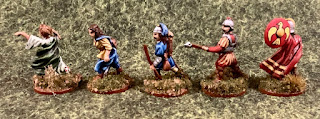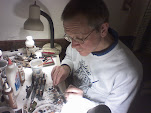TL;DR version: Got out some Prince August molds, cast things unrelated to any recent projects...
This has been an eventful month here in the United States, which has been interfering with my motivation to play with toy solders. I delayed a remote game expected to be played with my brother (a re-visit of Chainmail) and it’s now been several weeks since I laid out a game, and (until yesterday) as long since I put a brush to a figure.
However, I have been keeping my eyes open for anything interesting in vintage toy soldier molds, and recently received two packages containing these three molds:
 |
| Newly arrived vintage molds |
The top one is a Buck Rogers in the 25th Century mold, one which is new to the club collection. I foresee a resurgence in the influence of the Tigermen of Mars in the near future...
My brother has been practicing his sculpting again recently. (He’s the artistic one in the family.) That led him to think about mold-making and casting, so that he’ll be ready when he sculpts something he likes. He has a small collection of Prince August molds that I gave him a few years ago, and decided that he would finally get them out and try casting. He ordered a melting pot, and ten pounds of lead-free pewter (“Britannia metal”, an alloy of ~92% Sn, ~8% Sb, balance Cu, to be specific) from
Nathan Trotter. (You’ve got to love a company that’s been in the pewter business since 1789...). They were very polite about his inquiry and ten pound order and responded promptly, which is the sort of business style getting to be all too rare these days, so I wanted to give them a shout-out.
Prompted by his interest, I ended up deciding that it was finally time to convert over to lead-free material as well, so I ordered 25 pounds of the same material, and had it on my doorstep the next morning. The very same delivery also brought me my long-ago-preordered copy of
Oathmark, a new set of fantasy mass battle rules from Osprey Games, written by Joe McCullough, the author of
Frostgrave and
Ghost Archipelago.
 |
| Osprey’s latest, from the creator of Frostgrave |
I had agreed to watch over my brother’s shoulder (remotely, of course) as he tried casting, and then I set up my own casting equipment so that he could watch the way I did it. That’s how I ended up casting Prince August figures from rubber molds rather than trying out the new vintage mold collection.
 |
| Setting up the melting pots outdoors |
I decided that I would cast some figures I would want for my
Dux Bellorum project. To prepare for that, I went through my existing inventory of castings and started organizing them into unit sets. I concluded that I needed some horse, some shields, and some skirmishers, so I pulled out the appropriate molds and went to work.
I was interested to see that the Britannia metal has good flow characteristics, and my success rate in pours was pretty good.
 |
| Results of a casting session |
I had spent a little more time preparing the molds in advance, cutting additional vents pretty aggressively. I was pleased to find that the Persian cataphract figure (who at Prince August in 1982 thought that multiple part 25s was a good idea?) was suddenly casting with both arm variations and the open hand all in good shape.
 |
| Prince August 605, Persian Cataphract |
The bow and quiver will need to be removed or disguised to render him a more generic western Dark Ages horseman, but at least the multiple separate head system allows me to substitute something more generic (e.g. a spangenhelm) for the big Persian hat. It will be time to work on cavalry.
Because I needed shields, and also wanted the somewhat Roman-esque archer from the Prince August 652 (Men of the City) mold, I ended up pouring that mold quite a few times. Add the figures that were coming out reasonable well, and the new fantasy mass battle rules (which my brother also decided to buy), and the next thing I knew, I was deciding to do trial casting on all of the fantasy molds I own, especially the ones that have never been tested.
That had to wait until this weekend, though. To keep the process orderly, I decided that I would take them in catalog number order, starting with the molds I hadn’t used, so I skipped over 651 (Barbarians) and 652 (Men of the City) and started with 653 (Dwarves). You can see from the picture below what I mean about aggressive venting. However, it seems to have paid off, since between that and the new metal, the success rate was running above 75% yesterday.
 |
| Prince August 653, Dwarves (old mold) |
I tried molds 653-658 (Dwarves, Wood Elves, Orcs, Troll and Goblins, Wizards, and Armored Dwarves) as well as the half-armored Persian cataphract horse to go with last week’s rider. I turned out about 70 reasonable castings in a two hour session. Irene, my partner, wanted to know whether this was really cheaper than buying figures. I weighed the human-sized figures in the new metal, and it looks like one could expect about 40 25mm humans on foot from a pound of the material. At $12.50 per pound for a 25 pound order, that works out to less than 32 cents per figure in metal cost. With vintage 25s from Iron Wind metals running $3.50 or more, the answer is a resounding “Yes”. She also wanted to know how long the molds lasted, and I really don’t know the answer to that. The most-used 40mm NQSYW molds I own have produced hundreds of castings and seem to be fine. At $15/mold or so, the amortized cost of the molds is probably less than a penny per figure. The amount of time invested in the casting process is also not much; yesterday’s session averages out to less than two minutes per figure. There is certainly more time needed to prepare a home cast figure for painting than a commercial figure of similar complexity (i.e., if containing the same number of pieces needing assembly).
That leaves questions of art to be considered. An individual home cast figure, due to the limitations of the process, is going to be less detailed than a commercial spin-cast figure. On the other hand, simpler castings can be easier to paint, and that’s a plus if your goal is to fill the table with painted armies. On the third hand, the variety of castings in somewhat limited. On the fourth hand, limitations make good art...
My brother has tentatively decided that he is building his Oathmark armies with home cast figures (jumping into the deep end?). While considering the question of whether I am backing him up in this endeavor (in the hopes of running a joint game at a convention someday), I started painting a few trial castings.
 |
| Sorceress from Prince August 657 (Wizards) |
While the main benefit of casting things is that masses of troops are inexpensive, I do have molds for things that would only be needed in small numbers. I don’t think the sorceress came out badly as an individual.
 |
| Spearman from Prince August 652 (Men of the City) |
The spearman is one I cast last weekend. I’ve got five more sitting on my desk to be cleaned up, and we’ll see what a unit might look like.
I’d like to try a small skirmish with Oathmark before I write a rules review. My first observation, though, is that the use of a non-standard basing system is mildly off-putting. Units have a fixed maximum frontage of five figures, with a fixed base size of 25mm square for most foot. Prince August “true 25s” are going to look like they are in pretty loose order, so I am currently thinking that I am going to be using group movement (sabot) stands.
So that’s what’s been going on here. I’m glad to have painted anything, and hope to get back around to the French Revolution, the Renaissance, and even the NQSYW while I’m in the mood for home cast projects.










